Click on images to enlarge
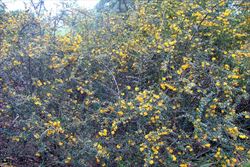
infestation (Photo: Sheldon Navie)
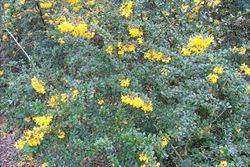
habit (Photo: Sheldon Navie)

habit (Photo: Sheldon Navie)
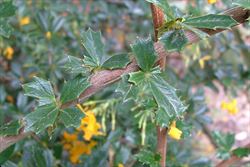
older stems with clusters of leaves on very short side-branches (Photo: Sheldon Navie)
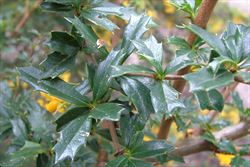
dark green glossy leaves with spine-tipped toothed margins (Photo: Sheldon Navie)
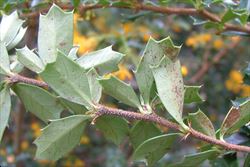
leaf undersides and hairy stems with spines (Photo: Sheldon Navie)
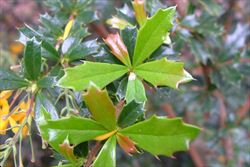
bright green young leaves (Photo: Sheldon Navie)
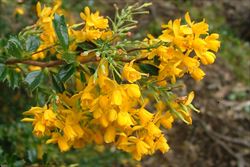
flower clusters (Photo: Sheldon Navie)
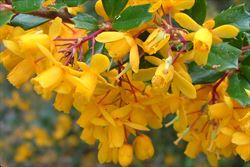
flowers (Photo: Sheldon Navie)
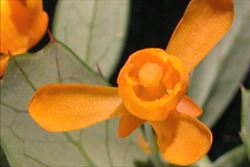
close-up of flower showing upright petals and spreading petal-like sepals in two rows (Photo: Greg Jordan)
Scientific Name
Berberis darwinii Hook.
Family
Berberidaceae
Common Names
barberry, berberis, Darwin's barberry, Darwin's berberis
Origin
Native to the southern parts of South America (i.e. Argentina and southern Chile).
Cultivation
Occasionally cultivated as a garden ornamental in the temperate regions of Australia.
Naturalised Distribution
Widely naturalised in the cooler temperate regions of south-eastern Australia (i.e. naturalised on the central tablelands of New South Wales, in southern Victoria and in Tasmania). It is also sparingly naturalised in South Australia and reported to be naturalised in the ACT.
Naturalised overseas in the UK, New Zealand, and western USA (i.e. California, Oregon and Washington).
Habitat
A weed of damp eucalypt forests, open woodlands, remnant bushland, forest margins, forestry plantations, roadsides and pastures in the cooler temperate regions of Australia.
Habit
An upright (i.e. erect) shrub usually growing 1-3 m tall, but occasionally reaching up to 4 m tall.
Distinguishing Features
-
an upright shrub growing 1-4 m tall with spiny main branches.
-
its glossy green leaves resemble 'holly leaves' and have several spiny teeth towards their tips.
-
these leaves (1-3 cm long and 5-15 mm wide) are are thick and rigid and borne in small clusters.
-
its yellowish flowers (about 10 mm across) are usually borne in elongated clusters.
-
its bluish or purplish berries (6-7 mm across) are usually covered in a whitish powder.
Stems and Leaves
The stems are hairy (i.e. pubescent) and have numerous short side-branches. Older stems are brown in colour, while younger stems are greenish and densely covered in brownish coloured hairs (i.e they are rusty pubescent).
The leaves on the main branches are reduced to 3-9 small spiny projections (5-10 mm long). The leaves on the very short side-branches are elongated to hexagonal in shape (1-3 cm long and 5-18 mm wide) with several spine-tipped teeth towards their tips (i.e. spinose apices). These leaves are borne on very short stalks (i.e. petioles) 1-3 mm long and are alternately arranged, but clustered very close together in small groups (each with 3-7 leaves) on the short side-branches. They are thick and rigid and have their edges turned under (i.e. reflexed margins). Their upper surfaces are dark green and glossy, while their undersides are paler and duller in appearance.
Flowers and Fruit
The yellowish to reddish-orange flowers are borne in elongated and drooping clusters (i.e. pendent racemes) 2-8 cm long that contain 10-30 flowers. Each flower (about 10 mm across) is borne on a reddish stalk (i.e. pedicel) about 10 mm long. These flowers have six yellow or reddish-orange spreading sepals that are petal-like and arranged in two rows. The outer three are relatively small, while the inner three are larger than the petals. The flowers also have six upright petals, six stamens and an ovary topped with a style and stigma (all yellow). Flowering occurs mainly during winter and spring (i.e. from August to November).
The fruit is a rounded (i.e. globose) berry (6-7 mm across) that is topped with persistent style (up to 3 mm long). These fruit turn from green to bluish, purplish or blackish in colour as they mature and are covered in a whitish powdery bloom (i.e. they are pruinose).
Reproduction and Dispersal
Darwin's barberry (Berberis darwinii) reproduces mainly by seed. These seeds are commonly spread by birds and other animals that eat the fleshy fruit. They may also be dispersed in dumped garden waste.
Environmental Impact
This species is regarded as an environmental weed in Victoria, ACT, Tasmania and New South Wales. It is currently also listed as a priority environmental weed in one Natural Resource Management region. In Victoria it has invaded relatively undisturbed wet sclerophyll forests in the Dandenong Ranges. Darwin's barberry (Berberis darwinii ) will eventually form dense impenetrable thickets if left unmanaged and it is considered to represent a potential threat to one or more vegetation formations in this state.
In New South Wales, Darwin's barberry (Berberis darwinii) has become established in bushland in the Blue Mountains, and is of concern in the wider Sydney and Blue Mountains region. It also has a restricted distribution in the ACT, but is considered to have a moderate to high weed potential in this region. In Tasmania several relatively small populations are being managed by government authorities (e.g. at Scottsdale in the north, at Fern Tree and Cockle Creek in the south, and at Williamsford in the west of the state) with the goal of eradication if possible.
This species is also invasive in a range of vegetation types in New Zealand, and is considered to be a serious threat to native species and ecosystems in many parts of this country too.
Legislation
This species is declared under legislation in the following states and territories:
- Tasmania: D - the importation or sale of this species is prohibited and measures to reduce its population in an area, eradicate it from an area, or restrict it to a particular area may be required.
- Western Australia: Unassessed - this species is declared in other states or territories and is prohibited until assessed via a weed risk assessment (throughout the entire state).
Similar Species
Darwin's barberry (Berberis darwinii) is very similar to Japanese barberry (Berberis thunbergii), Nepal barberry (Berberis floribunda) and common barberry (Berberis vulgaris). These species can be distinguished by the following differences:
- Darwin's barberry (Berberis darwinii) has densely hairy (i.e. tomentose) stems and thick and rigid leaves that remain on the plant year-round (i.e. it is evergreen). These leaves have a few (2-4) large teeth or small lobes that are each tipped with a small spine. Its rounded (i.e. globose) fruit turn bluish or purplish as they mature and they are covered in a whitish waxy bloom (i.e. they are pruinose).
- Nepal barberry (Berberis floribunda) has hairless (i.e. glabrous) stems and thin and flexible leaves that remain on the plant year-round (i.e. it is evergreen). These leaves several (4-16) small teeth along their margins, but they do not have any obvious spines. Its rounded (i.e. globose) fruit turn bright red or bluish as they mature and they are sometimes covered in a whitish waxy bloom (i.e. they are sometimes pruinose).
- Japanese barberry (Berberis thunbergii) has hairless (i.e. glabrous) stems and thin and flexible leaves that are shed during winter (i.e. it is deciduous). These leaves have entire margins and do not have any spines. Its oval-shaped (i.e. ellipsoid) fruit turn bright red as they mature and they are shiny in appearance.
- common barberry (Berberis vulgaris) has hairless (i.e. glabrous) stems and thin and flexible leaves that are shed during winter (i.e. it is deciduous). These leaves numerous (8-30) small teeth along their margins, but they do not have any obvious spines. Its oblong to egg-shaped (i.e. ovoid) fruit turn bright red as they mature.
It is also relatively similar to another closely-related group of plants also known as barberries (i.e. Mahonia spp.). However, these species do not have any spines on their stems and their leaves are divided into several leaflets (i.e. they have pinnate leaves).

